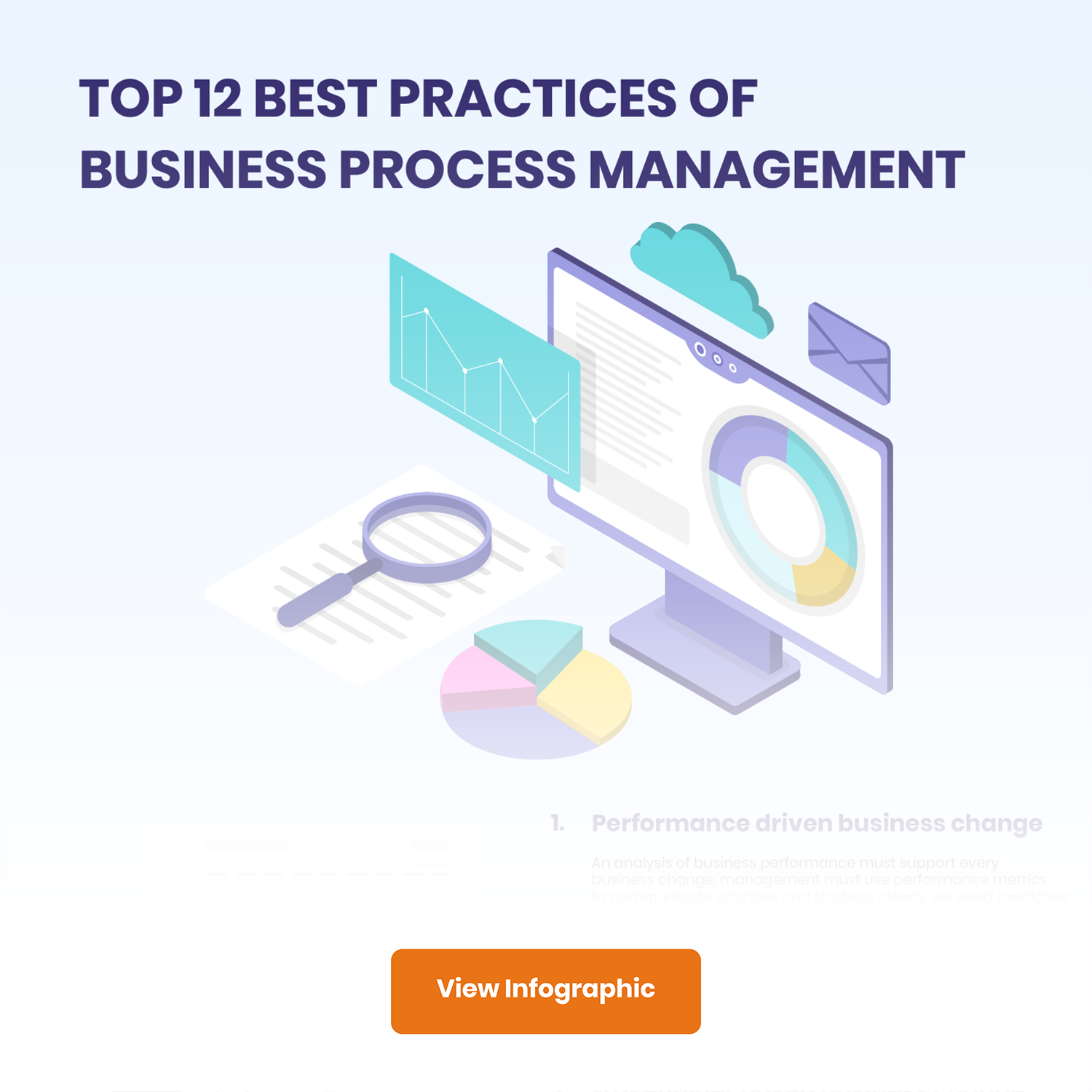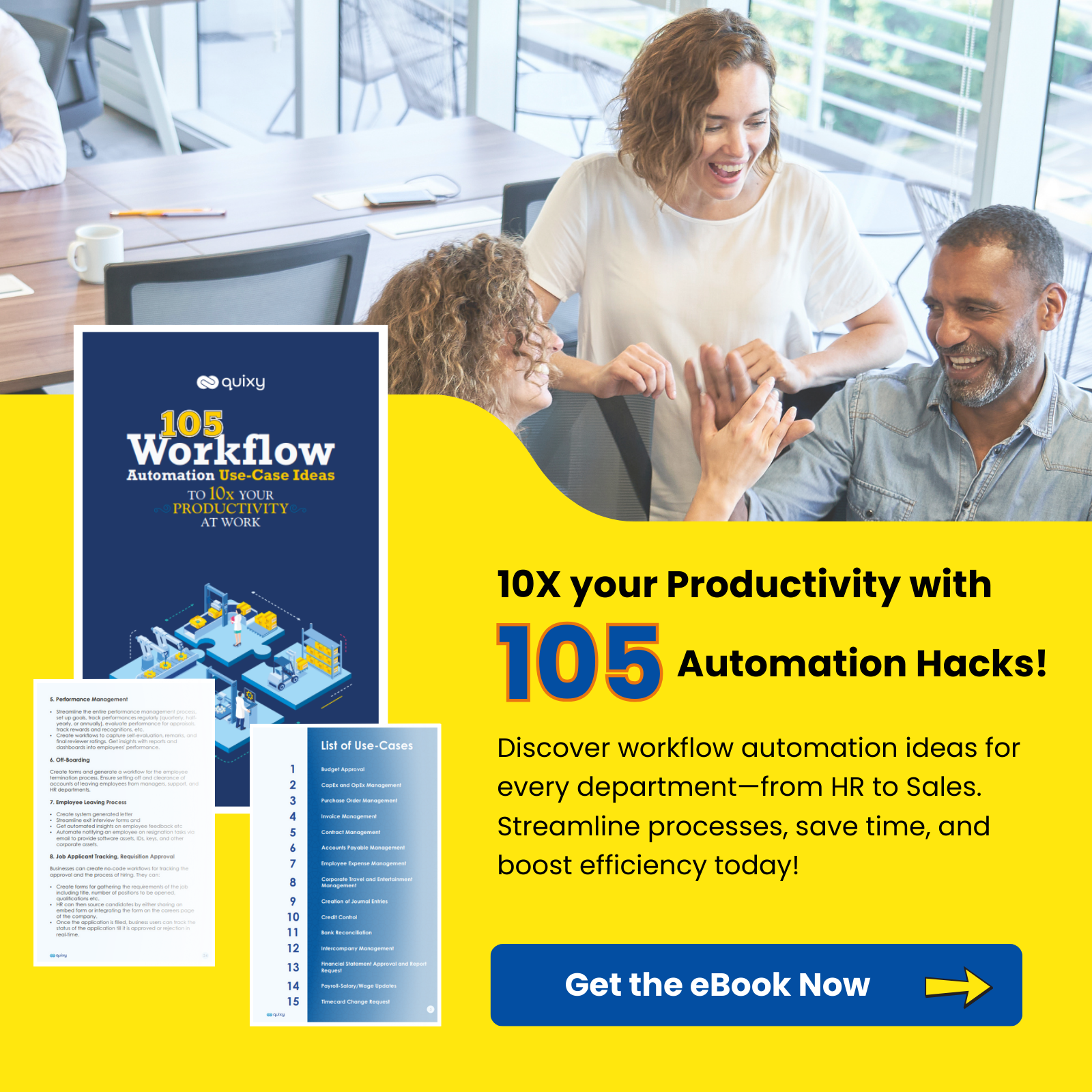
How do businesses develop and maintain the capacity for quick, low-risk, and cost-effective business process operations and automation changes? The conclusion of most studies on business process management lists several rather generic factors, e.g., top management support, communication, appropriate culture, the appointment of process owners, and end-user training.
For BPM initiatives to fulfill the promise of a comprehensive and sustainable transformation, we identified the 12 best practices of Business Process Management that represent a set of capabilities necessary for mastering current and future challenges in BPM.

Here are the Business Process Management Best Practices
1. Business change must be performance-driven
An analysis of business performance must support every business change. Every action should have a purpose, and measurement enables us to determine whether our actions align with the purpose.
We need predictive measures rather than retrospective reports to get the full picture. We must build a connected measurement system to deconstruct broad objectives into people’s daily activities. Management must use performance metrics to communicate priorities and strategy clearly rather than relying solely on desired outcomes.
Also Read: Human-Driven BPM: Discover 5 Powerful Ways to Transform Processes
2. Divide the organization along business process lines
Since management structures with excessively rigid planning mechanisms are too slow to react, it is only natural to view the process as the primary segmentation strategy within and—more frequently—among organizations. Cross-functional integration must be seamless; simply restructuring operational units won’t cut it.
Because a process begins with the first triggering event that starts the action and continues until the value results are delivered to the appropriate stakeholders, only processes can claim to have achieved enterprise-wide integration. This event/outcome pairing defines the processes we have. The sole purpose of all additional structures should be to support the entire process and thereby provide added value to stakeholders.
3. Stakeholder-based business change is essential

Anyone or any group impacted by has a stake in or has the potential to significantly affect a business’s performance is referred to as a stakeholder. Types should be divided into groups based on their unique requirements and how they should be handled.
To comprehend each stakeholder group, it is essential to understand our current relationship with that group and how we would like it to develop. The difference between these two states will motivate our need for change, and the stakeholder criteria will be balanced based on the stakeholders’ actual needs.

4. Engage the populace in business change
Without a thorough understanding of internal challenges, no BPM initiative is finished. It is a common mistake to overlook the role of people in business process operations. Things will likely go smoothly once the process is up and running if you consider solutions to their problems when designing your strategy.
You must support changes in addition to your communications plan with the right roles and responsibilities, organizational frameworks, empowerment within accountability, coordinated business performance incentives and recognition, and chances for personal development. The staff must believe that a trustworthy level of communication is taking place during the transition. As a result of their participation, they ought to feel like they contributed.
Also Read: 10 Valuable Benefits of Business Process Management
5. Iterative and time-boxed process renewal initiatives
Business performance works under the premise that people don’t know everything upfront and must foster an environment where they can learn things and express them gradually. This iterative method is predicated on the idea that you must first attempt changes at a relatively high level of abstraction before getting too specific.
According to time-boxing, the activity schedule must be predetermined, and the amount of work completed varies depending on what can be finished in the allotted time. Scheduling the participants, particularly process management, for important reviews, one of the biggest issues in process-oriented change situations, is also resolved.
Also Read:Top 15+ Business Process Automation Examples You Need to Know
6. Use the black-box method
Organisations and processes should use the black-box method. For instance, we will look at each process individually to see how it functions with its internal and external stakeholders. Each process will be broken down into its subsequent level of activities, which will all be looked at.
By doing this, we’ll maintain the proper level of detail in our analysis and design. We will concentrate on the most important aspects, not all of them. Before continuing, we will know the motivators and have the necessary insight.
7. Check the BPM tool’s suitability

It would be a serious resource waste and counterproductive to your efforts if your BPM tool did not match the actual needs of your business. Before choosing a successful BPM tool, consider organizational capabilities, business process operations requirements, technological requirements, and funding availability.
It’s always best to adopt a tailored and nuanced approach to your organization’s needs when using best practices of Business Process Management. In the end, the actions taken to enhance processes shouldn’t turn into a time and effort waster.
Also Read: Step Into Success With These 7 Business Process Management Examples
8. Initiatives must spark shared insight
Information gathering, understanding, and arriving at novel approaches and designs for business change are crucial components of process renewal. Experience has shown that relying solely on one strategy is dangerous. The learning curve is quickly accelerated by close interaction with “knowers.” This type of learning is manageable because everyone can recognize reliable sources of process information, especially in focused areas of an organization.
A business improvement needs more formal methods as its focus widens to share what it knows. Accessible knowledge artifacts are crucial for bridging the knowledge gap, frequently taking the form of explicit documents.
9. Decisions must be traceable to stakeholder criteria
This principle guarantees that before choosing between business options, we obtain accepted criteria and use those criteria rather than internal personal drivers. We cannot anticipate optimizing results if the criteria drivers are also out of sync with the organization’s mission, vision, and values, as well as with the expectations of its stakeholders.
Process management must consciously and publicly agree on the criteria first and only then publish them. Additionally, process management must give those implementing business change the freedom to think outside the box or in line with the objectives of outside parties.
Also Read: What is a Business Process? 7 Practical Examples
10. Provide team members with regular training

Few businesses have been able to keep up with employee training due to the rapid pace of change in business process operations, technology, and markets. Companies occasionally use workarounds to process to complete tasks. These workarounds can keep business process operations going but can also lead to inefficiencies, increased costs, and decreased quality.
Most recently, during the pandemic, we witnessed this as businesses rushed to adopt an operating model for remote workplaces. For many businesses, efficiency—and teaching employees the proper procedures—was frequently a secondary consideration as they made the necessary adjustments.
11. Choose the appropriate KPI
Completing accurate data for your process models is the first step in conducting serious performance measurements. Maintaining thorough, current information throughout the project is equally important. Be sure to specify what will be measured, why, how, and where the data will come from as current and future state BPM process models are developed.
Process mining technologies improve performance insights by using AI and other analytics on the process data related to your activities. Although setting it up can take a lot of work, most businesses find the data obtained through process mining very valuable. These tools can record performance in real-time so that project participants can keep track of it.
12. Enjoy the journey of business change
Process management and business process re-engineering (BPR) initiatives that swept past us in the early and middle 1990s differ significantly in their approaches to continuity of effort. The management of BP aspires to uphold the idea of supporting the ongoing management of changes that have been implemented or changes that are still being implemented.
Today, two important business improvement factors must be considered: we don’t have enough time to do everything perfectly; therefore, anything we do will need to be adjusted as we gain experience in the market. Second, no matter how righteous our actions are, they will all be transient and require modification.
Also Read: 23 Must-Have Features of a BPM Platform that you definitely need!
Your Ideal Partner
Quixy can get you on the right track toward process improvement. It is a cloud-based BPM tool that doesn’t require coding and is simple to integrate with your current applications. Powerful reporting and extensive dashboards can increase process transparency and offer insightful data.
Quixy is the ideal partner for your company’s growth strategy because of its BPM ease of scale. Get started with our platform, and experience the ease of automated processes and personalized app building.
Login
Please login to comment
0 Comments
Oldest
















